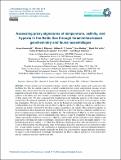Assessing proxy signatures of temperature, salinity, and hypoxia in the Baltic Sea through foraminifera-based geochemistry and faunal assemblages
Abstract
Current climate and environmental changes strongly affect shallow marine and coastal areas like the Baltic Sea. This has created a need for a context to understand the severity and potential outcomes of such changes. The context can be derived from paleoenvironmental records during periods when comparable events happened in the past. In this study, we explore how varying bottom water conditions across a large hydrographic gradient in the Baltic Sea affect benthic foraminiferal faunal assemblages and the geochemical composition of their calcite tests. We have conducted both morphological and molecular analyses of the faunas and we evaluate how the chemical signatures of the bottom waters are recorded in the tests of several species of benthic foraminifera. We focus on two locations, one in the Kattegat (western Baltic Sea) and one in Hano Bay (southern Baltic Sea). We show that seawater Mn/Ca, Mg/Ca, and Ba/Ca (Mn/Casw, Mg/Casw, and Ba/Casw) variations are mainly controlled by dissolved oxygen concentration and salinity. Their respective imprints on the foraminiferal calcite demonstrate the potential of Mn/Ca as a proxy for hypoxic conditions, and Ba/Ca as a proxy for salinity in enclosed basins such as the Baltic Sea. The traditional use of Mg-Ca as a proxy to reconstruct past seawater temperatures is not recommended in the region, as it may be overprinted by the large variations in salinity (specifically on Bulimina marginata), Mg/Casw, and possibly also the carbonate system. Salinity is the main factor controlling the faunal assemblages: a much more diverse fauna occurs in the higher-salinity (similar to 32) Kattegat than in the low-salinity (similar to 15) Hano Bay. Molecular identification shows that only Elphidium clavatum occurs at both locations, but other genetic types of both genera Elphidium and Ammonia are restricted to either low-or high-salinity locations. The combination of foraminiferal geochemistry and environmental parameters demonstrates that in a highly variable setting like the Baltic Sea, it is possible to separate different environmental impacts on the foraminiferal assemblages and therefore use Mn/Ca, Mg/Ca, and Ba/Ca to reconstruct how specific conditions may have varied in the past.
Citation
Groeneveld , J , Filipsson , H L , Austin , W E N , Darling , K , McCarthy , D , Krupinski , N B Q , Bird , C & Schweizer , M 2018 , ' Assessing proxy signatures of temperature, salinity, and hypoxia in the Baltic Sea through foraminifera-based geochemistry and faunal assemblages ' , Journal of Micropalaeontology , vol. 37 , no. 2 , pp. 403-429 . https://doi.org/10.5194/jm-37-403-2018
Publication
Journal of Micropalaeontology
Status
Peer reviewed
ISSN
0262-821XType
Journal article
Description
We acknowledge funding through the Swedish Research Council (VR) (project no. 621-2011-5090), the German Research Council (project GR 3528/3-1), the Lamm Foundation, the Centre for Environmental and Climate Research at Lund University for Jeroen Groeneveld’s guest research stay, NERC grants NE4/G018502/1 and NE/G020310/1 to William E. N. Austin, and the University of Bremen for covering the article processing costs for this open-access publication.Collections
Items in the St Andrews Research Repository are protected by copyright, with all rights reserved, unless otherwise indicated.

